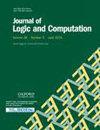ASPECT:将答案集以矢量图的形式重新呈现在 laTex 中
IF 0.7
4区 数学
Q3 COMPUTER SCIENCE, THEORY & METHODS
引用次数: 0
摘要
逻辑编程是一种声明式编程范式,在人工智能(AI)领域得到广泛应用。因此,它已成为大学课程中教授学生人工智能技术的重要工具。除 Prolog 语言外,最新的答案集编程(ASP)语言也因其语言的表现力和高效的求解系统而成为开发高级应用程序的有力工具。遗憾的是,ASP 求解器的输出可能难以解释,因为它是一组原子,通常冗长而啰嗦。对于学习这种语言的学生或为复杂的实际问题开发应用程序的专家来说,这种情况最为明显。出于这些原因,在可能的情况下,生成解算器输出的图形表示法的能力变得非常有用,可以确保更容易地解释结果。在本文中,我们介绍了 ASPECT,这是 ASP 的一种子语言,用户可以用直观和声明的方式直接定义答案集的图形表示。ASPECT 原子可以转换成流行的 LaTeX 标记语言,以生成矢量图形。ASPECT 生成的文档可轻松嵌入科学文章、课程讲义和演示文稿等文档中。此外,开发用户友好界面对于类似技术在工业领域的广泛应用也至关重要。此外,ASPECT 还可扩展用于处理时间信息,并提供包含时间维度的答案集图形动画,例如在规划问题中。最后,我们提倡使用 ASPECT 从声明式规范开始创建复杂的动画演示。本文章由计算机程序翻译,如有差异,请以英文原文为准。
ASPECT: Answer Set rePresentation as vEctor graphiCs in laTex
Logic programming is a declarative programming paradigm that finds extensive use in the field of Artificial Intelligence (AI). As a result, it has become a valuable tool used in university courses for teaching students AI techniques. Besides Prolog language, the more recent Answer Set Programming (ASP) language turns out to be a powerful tool for developing advanced applications due to the expressiveness of the language and the availability of efficient solving systems. Unfortunately, the output of ASP solvers can be difficult to interpret, since it is a set of atoms, often long and verbose. This is most true in the case of students learning the language or in the case of experts developing applications for complex real-world problems. For these reasons, the ability to produce, when possible, a graphical representation of the solver output becomes useful to ensure easier interpretation of the results. In this paper we present ASPECT, a sub-language of ASP in which the user can directly define, in an intuitive and declarative way, a graphical representation of the answer set. The ASPECT atoms can be converted into the popular LaTeX markup language to produce vector graphics. The documents produced by ASPECT are easy to embed in documents such as scientific articles, course handouts and presentations. Also, the development of user-friendly interfaces is critical for wider use of similar technologies in the industrial sector as well. Moreover, ASPECT is also extended to deal with temporal information, and provide graphical animations of answer sets that enclose the temporal dimension, such as in planning problems. Finally, we advocate the use of ASPECT to create complex and animated presentations starting from a declarative specification.
求助全文
通过发布文献求助,成功后即可免费获取论文全文。
去求助
来源期刊

Journal of Logic and Computation
工程技术-计算机:理论方法
CiteScore
1.90
自引率
14.30%
发文量
82
审稿时长
6-12 weeks
期刊介绍:
Logic has found application in virtually all aspects of Information Technology, from software engineering and hardware to programming and artificial intelligence. Indeed, logic, artificial intelligence and theoretical computing are influencing each other to the extent that a new interdisciplinary area of Logic and Computation is emerging.
The Journal of Logic and Computation aims to promote the growth of logic and computing, including, among others, the following areas of interest: Logical Systems, such as classical and non-classical logic, constructive logic, categorical logic, modal logic, type theory, feasible maths.... Logical issues in logic programming, knowledge-based systems and automated reasoning; logical issues in knowledge representation, such as non-monotonic reasoning and systems of knowledge and belief; logics and semantics of programming; specification and verification of programs and systems; applications of logic in hardware and VLSI, natural language, concurrent computation, planning, and databases. The bulk of the content is technical scientific papers, although letters, reviews, and discussions, as well as relevant conference reviews, are included.
 求助内容:
求助内容: 应助结果提醒方式:
应助结果提醒方式:


